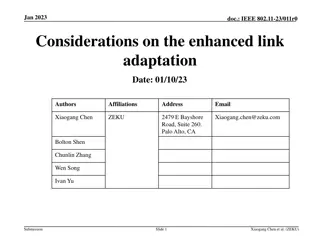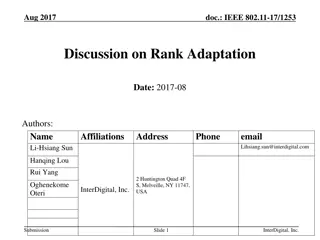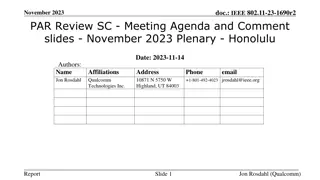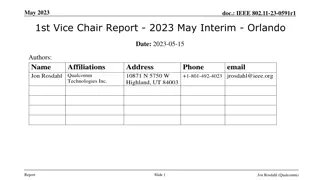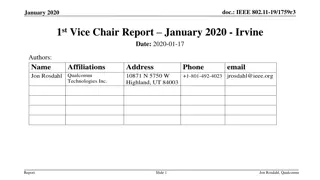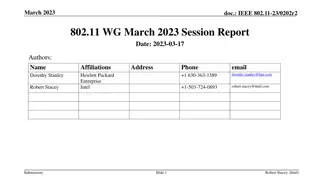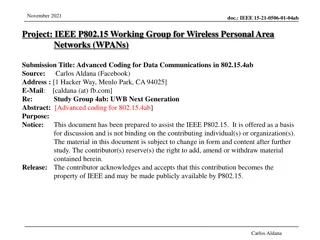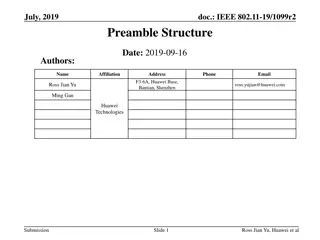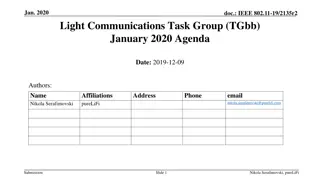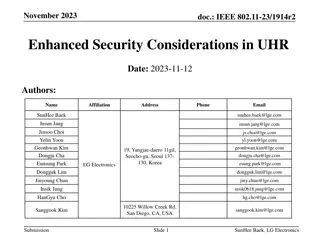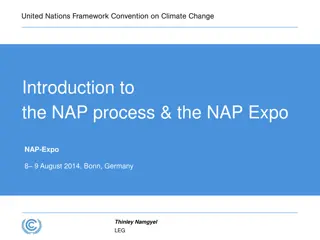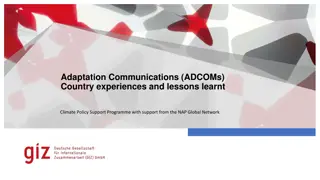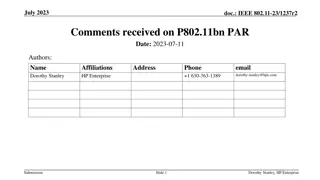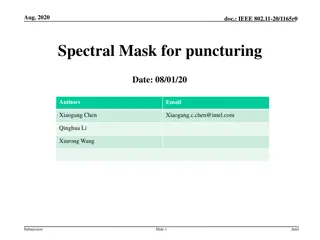IEEE 802.11-23/711r0 May 2023 Document Summary: Enhanced Link Adaptation Discussions
The May 2023 document IEEE 802.11-23/711r0 discusses topics like beamforming feedback, closed-loop rate adaptations, and issues related to beamforming feedback in a wireless communication context. It elaborates on the challenges of feedback optimization and post-SNR degradation, suggesting solutions and improvements. The document also touches upon the significance of rotated beamforming vectors, channel capacity maximization, and inter-stream interference considerations. The discussions explore the role of rotation in improving post-SNR for spatial streams and clarifications on nSS selection based on average SNR. Various simulation results and analysis outcomes are presented to support the arguments and findings.
Uploaded on Sep 23, 2024 | 0 Views
Download Presentation

Please find below an Image/Link to download the presentation.
The content on the website is provided AS IS for your information and personal use only. It may not be sold, licensed, or shared on other websites without obtaining consent from the author. Download presentation by click this link. If you encounter any issues during the download, it is possible that the publisher has removed the file from their server.
E N D
Presentation Transcript
May 2023 doc.: IEEE 802.11-23/711r0 Follow up on the enhanced link adaptations Date: 04/25/23 Authors Affiliations Address Email Xiaogang Chen ZEKU 2479 E Bayshore Road, Suite 260. Palo Alto, CA Xiaogang.chen@zeku.com Bolton Shen Chunlin Zhang Wen Song Ivan Yu Submission Slide 1 Xiaogang Chen et al. (ZEKU)
May 2023 doc.: IEEE 802.11-23/711r0 Outline Clarifications, simulations and discussions on the beamforming feedback. Discussions on the closed loop rate adaptations. Submission Slide 2 Xiaogang Chen et al. (ZEKU)
May 2023 doc.: IEEE 802.11-23/711r0 Recap of the issue on the Bfing feedback (1/2) The average SNR gap between two SS in Bfed data could be as large as more than 10dB with an average of ~7.5dB [1]; 11be uses only one MCS for data transmission. One MCS needs to adapt to 2SS with a large gap in post-SNR. Considerable gains is demonstrated in [1] by feeding back the rotated Bfing matrix: Instead of feeding back ??? ? ???= ?1 Feed back ?2, ????=??? ?,where ? =cos? sin? cos? . sin? Submission Slide 3 Xiaogang Chen etc. (ZEKU)
May 2023 doc.: IEEE 802.11-23/711r0 Recap of the issue on the Bfing feedback (2/2) Issue is STA with two chains always feedback two SS and may optimize the feedback assuming two SS by feedback ???? instead of ??? (SVD) Currently AP has no knowledge on STA s optimization and may chose the 1st column of ???? and the postSNR degrades: ? ?? ?? ? ?1= ?1 ?1 ??????????= ????_???= ? ? ?1 ?2 ? (?1 cos? + ?2 sin?) = ? ? cos? ????_???= ? ? ?1 ?2 sin? ??????+?? ?????? ?? ??????????= ?? <= ??????????(????????). . = is true only If ? = 0. . ?????????? <= Considerable loss was demonstrated that align with the analysis [1]. Submission Slide 4 Xiaogang Chen etc. (ZEKU)
May 2023 doc.: IEEE 802.11-23/711r0 Discussions and clarifications (1/4) Where the gain comes from? Rotated Bfing vector is not the optimal vector to maximize channel capacity; Rotation also introduces inter-stream interference; However, after rotation, the post SNR could be the same for the two spatial streams. Given single MCS is used for two SS, rotation provides gain. Clarifications for other questions 1. Leveraging the average SNR to recommend/force AP do nSS selection? The average SNR in CBF may not be used for rate adaptation since the sounding frequency could be once per tens or hundred of ms. [1] already showed that different nSS was selected within one sounding instance. Submission Slide 5 Xiaogang Chen etc. (ZEKU)
May 2023 doc.: IEEE 802.11-23/711r0 Discussions and clarifications (2/4) 2. Not much gain was observed when rotation is applied in some simulation. When rotation is applied, ML equalizer demonstrates more gain than MMSE due to the robustness to inter-stream interferences (table on the left). 3. If ML receiver is used, is there any gain comparing Bfed with rotation vs. non- Bfed (table on the right)? SVD vs Rotation, 4x2x2, ChB, 20MHz, EHT 4x LTF, LDPC, MMSE Bfed vs non-Bfed 4x2x2, ChB, 20MHz, EHT 4x LTF, LDPC, MLD MCS Gain(dB) MMSE MCS Sensitivity Bfed (dB) Sensitivity non- Bfed (dB) Gain(dB) 0 1.2 0 6.1 6.7 0.6 1 0.3 1 9.1 9.9 0.8 2 0.8 2 12.1 13.7 1.6 3 -1.5 3 15.8 18.1 2.3 4 0.2 4 19.3 21.9 2.6 5 -0.9 5 24.2 27.4 3.2 6 -0.3 6 25.5 29.0 3.5 7 0.2 7 27.1 30.9 3.8 8 -0.7 8 31.3 35.3 4.0 9 -0.1 9 32.8 37.1 4.3 Submission Slide 6 Xiaogang Chen etc. (ZEKU)
May 2023 doc.: IEEE 802.11-23/711r0 Discussions and clarifications (3/4) Duplicated feature with Unequal Modulation (UEQM)? Not really. UEQM Is a substantial feature to maximize capacity in theory given a proper rate adaptation is conducted by transmitter. Needs standardization efforts to chose the proper MCS. Needs fine turn on Tx given that a new dimension (spatial stream) is added for MCS adjustment. Fully controlled by Tx, may need time to deploy in the field. Rotation: Spec transparent; Existing rate adaptation can be reused; Could be adopted in the field in short term. Both schemes can be developed together for short-term and long-term deployment respectively. Submission Slide 7 Xiaogang Chen etc. (ZEKU)
May 2023 doc.: IEEE 802.11-23/711r0 Discussions and clarifications (4/4) Other work around: Rule of thumb: a feature that solely rely on transmitter is hard to guarantee without certification. Rely on AP to rotate or do power allocation -> basically nothing will be implemented. In the non-TB CBF frame, BFee recommend nSS to BFer or BFer indicate nSS to BFee: Could be a solution but nSS may still be overwrite by Bfer s rate adaptation algorithm Way forward: Alt. 1: Feedback both 1ss and 2ss Overhead: given a STA with 2 chains always feedback 2ss in CBF already, the extra overhead is the 1ss CBF. 946/1883 Bytes for 80/160MHz respectively in every 50/100ms; 1-2ms (non-HT-DUP 6Mbps) or 0.2ms (MCS0 EHT) -> marginal extra overhead in reality. Implementation impacts: SU Bfee: Optional. Bfee may chose to optimize or not. SU Bfer: Mandatory to Parsing the MIMO control field and the CBF with nSS = 1+2 ; Save the Bfing vectors for both 1ss and 2ss respectively and apply the vectors to the SU-Bfed data. Alt.2: Recommend nSS (Nc) in non-TB CBF, to align the nSS in CBF with Bfed data. may be overwrite by Bfer s rate adaptation algorithm. Submission Slide 8 Xiaogang Chen etc. (ZEKU)
May 2023 doc.: IEEE 802.11-23/711r0 Recap of the observations in [1] for rate adaptation Transmitter try to maintain higher rate when channel degrades -> Retransition is triggered frequently (left figure and [1]) Transmitter is conservative to increase rate when channel condition recovers (right figure copied from [1]). Submission Slide 9 Xiaogang Chen etc. (ZEKU)
Jan 2023 doc.: IEEE 802.11-23/711r0 Emulating the come&go of ACI Rx settles on a rate with the presence of the ACI. ACI could be in-band Bluetooth working in FDD with Wi-Fi; ACI Setup is the same as [1]. For a period of time (on the order of seconds or even longer), the Rx cannot work on the highest MCS that it indicated to support in the capability due to the presence of ACI. ACI is not present. ACI is present. It s better to inform the Tx a MCS cap within this duration to avoid the MCS climbing/dropping back and force which introduces too many retries. ACI is not present. ACI is present. ACI is not present. ACI is present. ACI is not present. Xiaogang Chen etc. (ZEKU) Submission Slide 10
May 2023 doc.: IEEE 802.11-23/711r0 Thoughts on the feedback (1/2) What information need to feedback? The presence of interferences; May report next level of details such as: Time (expected duration to determine long term or short term); Frequency for punctured transmission (some in-device information is only available to Rx. E.g. restrict the BT hopping within a narrow band). MCS Cap recommendation for long term; MCS recommendation for short term?? How the transmitter leverage the feedback? Link switch depends on the predicted duration of the interference and link availability; Maximum supported MCS adjustment; Short term MCS fine tune. Slide 11 Submission Xiaogang Chen etc. (ZEKU)
May 2023 doc.: IEEE 802.11-23/711r0 Thoughts on the feedback (2/2) Where those information can be carried? BA for fastest response OMI for long term A-Control? Not widely implemented so far. Certification will help the technology adoption. Link adaptation focused certification has been done for other technologies; Throughput comparison was also used during the test of many other features in the certification of 11ax/11be. Link adaptation focused certification in 11bn should not be difficult to conduct and demonstrate gain. Submission Slide 12 Xiaogang Chen etc. (ZEKU)
May 2023 doc.: IEEE 802.11-23/711r0 Summary The benefit of rotated beamforming feedback is further explained; Standing out questions have been clarified with further simulations. Feedback to aid rate adaptation is further discussed; In-device coex will be a beneficiary if proper information is fed back. Can potentially help other use cases if certification can be enforced. Submission Slide 13 Xiaogang Chen et al. (ZEKU)
May 2023 doc.: IEEE 802.11-23/711r0 Reference [1] 11-23-0011-00uhr On the enhanced link adaptation. Submission Slide 14 Xiaogang Chen etc. (ZEKU)
May 2023 doc.: IEEE 802.11-23/711r0 Backup Gap (dB) ChDNLoS Sensitivity(dB@10% PER) Gap (dB) ChDNLoS Rot A-SVDRot B-SVD -5.089 -5.654 -3.71 -2.834 -1.881 -3.247 -3.525 -3.333 -1.805 -1.461 -1.827 -2.618 -2.472 -1.291 -0.68 Sensitivity(dB@10% PER) SVD Rot A 15.577 10.488 28.996 23.342 Ntx 2 2 2 2 2 4 4 4 4 4 8 8 8 8 8 Nrx 2 2 2 2 2 2 2 2 2 2 2 2 2 2 2 Bw(MHz) 20 20 MCS 0 4 Nss 2 2 Rot B 10.421 25.048 Rot A- SVD Rot B-SVD 1.479 3.408 4.831 5.296 5.502 5.749 5.669 5.655 6.283 6.229 5.566 5.864 MCS 0 1 2 3 4 5 6 7 8 9 10 11 Nss 1 1 1 1 1 1 1 1 1 1 1 1 SVD Rot A Rot B -5.156 -3.948 -2.394 -0.547 -0.02 -3.134 -2.398 -2.243 -0.677 -0.403 -1.606 -1.974 -1.32 -0.641 -0.101 0.164 0.963 1.826 2.088 2.381 2.458 2.388 2.409 2.473 2.464 2.278 2.145 1.512 2.991 1.676 1.641 5.049 2.604 20 20 7 9 2 2 37.109 41.577 33.399 38.743 34.715 41.030 3.065 7.896 4.891 4.853 10.149 6.941 20 80 80 11 0 4 2 2 2 47.637 7.984 20.886 45.756 4.737 17.361 47.617 4.850 18.488 8.267 13.769 10.648 11.549 17.298 14.007 80 80 7 9 2 2 28.716 32.771 25.383 30.966 26.473 32.094 13.210 18.879 15.598 15.168 20.823 17.577 80 160 160 11 0 4 2 2 2 38.266 3.468 15.414 36.805 1.641 12.796 37.863 1.862 13.440 18.369 24.652 20.842 20.476 26.705 22.940 160 160 7 9 2 2 22.963 27.520 20.491 26.229 21.643 26.879 23.711 29.277 25.989 26.280 32.144 28.425 160 11 2 33.028 32.348 32.927 Submission Slide 15 Xiaogang Chen etc. (ZEKU)


